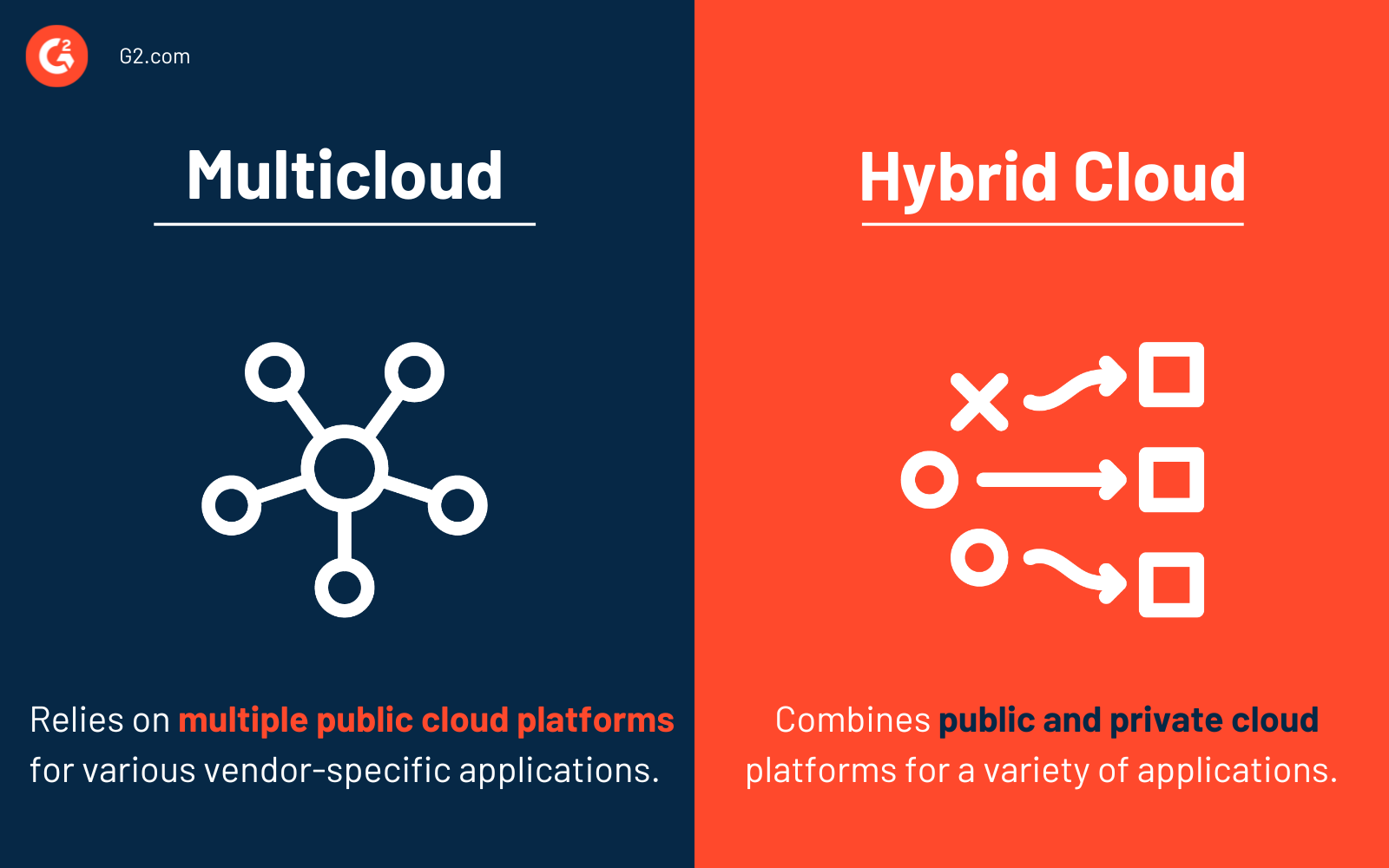If you work in a data-heavy organization, you’ve probably heard of cloud migration.
Cloud migration is the process of moving organizational processes and data centers over to cloud platforms from the existing on-premise infrastructure.
Adopting cloud infrastructure has now become an astute decision for businesses around the world because of the on-demand availability of resources and computing power it provides. With the world going digital over the last decade, cloud environments have gained heavy traction in many industries.
With more cloud computing platforms jumping on the bandwagon to provide quality services, companies are spoiled by choice with cloud computing strategies. Let’s explore a very popular strategy that has caught on in recent years thanks to its flexibility and feasibility: the multicloud.
What is a multicloud?
A multicloud is a cloud computing strategy that employs two or more cloud computing service providers on a single network architecture for an organization.
For a company migrating its SaaS applications and processes to the cloud, choosing the right cloud service provider is of utmost priority. Cloud service providers are primarily categorized into private, public, and hybrid platforms.
Private cloud platforms employ an organization’s own cloud computing resources and are generally adopted by smaller organizations with a higher security requirement.
Public cloud platforms use third-party-owned cloud services and their infrastructure as well. They are the most commonly used cloud platforms because of their lower cost and greater scalability. Some common examples of public cloud providers include Amazon Web Services (AWS), Microsoft Azure, and Google Cloud Platform (GCP).
Hybrid cloud platforms are a combination of both public and private and are tailored to fit an organization's business needs.
Multicloud strategies adopt different cloud storage and cloud management platforms for different precincts and departments in the organization. The workload on each application is balanced on multiple Infrastructure as a Service (IaaS) and Platform as a Service (PaaS) software.
A multicloud also provides a secure cloud migration approach since multiple vendors provide a multi-layered cloud security solution for each application.
Key elements of a multicloud strategy
Cloud migration is a complex, detail-oriented process. A multicloud strategy also involves multiple stakeholders and choices for each individual application. There are a few important aspects that demonstrate the importance of any multicloud strategy adoption in an organization.
Here the some of the key elements that businesses need to keep in mind when implementing a multicloud platform strategy:
Mapping cloud architecture
High-level cloud architecture planning for each of your business applications can work cohesively in terms of budget and productivity optimization. Each application and department of your organization has different cloud vendor needs, and they need to be monitored frequently to ensure the cloud platforms are being leveraged efficiently.
Planning application integration
Multicloud platforms employ a variety of cloud infrastructures in a single organization. Integrating cloud services and data migration among multiple applications should be a major area of consideration when employing a multicloud strategy.
Organizations need to ensure a seamless integration in order to guarantee that the multiple cloud platforms keep functioning smoothly.
Establishing automation
Cloud platforms provide an excellent automation framework for most procedures. It’s important to establish an automation strategy that makes use of your current automation tools and ensures an effortless running of cloud platforms among your applications. Cloud environments can communicate with each other, making processes smoother and automating repetitive ones involving more than one application.
Understanding the infrastructure needs
Network and infrastructure needs keep changing with business expansion and time. When your organization diversifies its products and continues to grow, your cloud infrastructure may need better on-premise infrastructure, storage, and faster computing machines.
When employing a multicloud approach, an organization has to keep in mind that they need to upgrade their infrastructure from time to time in order to keep up with the cloud scalability and ensure that performance remains optimum.
Future cloud strategy
Cloud platform strategies, like every other business aspect, need to be upgraded regularly and efficiently. Planning ahead is a must in the case of multicloud adoption since the applications opting for one cloud service provider today may find their needs suited by another after their markets change and requirements grow.
Growing needs may include cloud adoption for more applications, cloud training for a larger workforce, and lesser latency tolerance in certain data centers. Organizations should strive to have a contingent future cloud strategy ready for each business area.
Vous voulez en savoir plus sur Plateforme Cloud en tant que Service (PaaS) Logiciel ? Découvrez les produits Plateforme en tant que service (PaaS).
Multicloud vs. hybrid cloud
Traditionally, hybrid cloud platforms were adopted by growing businesses because of the multitude of applications and services they support. With more companies migrating to the cloud, companies saw a need to embrace a cloud migration strategy that would allow them to use separate cloud platforms for their database management, IaaS and PaaS needs, and security requirements.
A multicloud strategy provided a perfect solution for this issue. It allowed stakeholders to decide on the scale and type of migration they needed to adopt for their particular application.
Hybrid cloud and multicloud strategies both use multiple platforms, often a combination of both private and public cloud.

Hybrid cloud infrastructure involves a congregation of public and private cloud platforms for a variety of applications across the organization. It combines various public cloud platforms with an on-premise infrastructure. It ensures the security of a company’s server and provides a large number of public cloud benefits such as scalability and smooth integration.
On the other hand, multicloud strategy employs multiple public cloud platforms and infrastructure for various applications from different vendors, depending on the business requirements.
Multicloud deployments can also involve an on-premise infrastructure if the organizational needs demand so. In a multicloud model, different cloud platforms are used for different applications, hence reducing the dependency on a single cloud provider for the entire business.
Key takeaway: The prime difference between hybrid and multicloud strategies is the use of multiple cloud service providers instead of types of cloud platforms.
Multicloud strategies can involve solely public cloud platforms, but a hybrid cloud deployment strategy has to involve both public cloud platforms and private cloud infrastructure.
Advantages of multicloud computing
A multicloud strategy has been adopted by more than 98% of enterprises around the world in 2019. It offers a plethora of benefits with its flexible structure and easy scalability. For companies migrating to the cloud, multicloud platforms provide a robust option regardless of the size and budgetary constraints of an organization.
Let’s take a look at the primary benefits that multicloud platforms provide:
Cost optimization
A multicloud strategy gives organizations the option to choose the most affordable cloud service provider in the market best suited for their needs. Since a multicloud strategy also involves employing both private and public cloud platforms for applications, cost optimization can be planned from the grassroots level in order to end up with an optimized budget plan.
Lesser dependency on a specific cloud provider
A multicloud strategy helps organizations avoid vendor lock-in for any application. If a certain cloud provider or type of cloud platform doesn’t work out for the business, they can always switch over to a different option without jeopardizing the entire cloud strategy. A multicloud strategy is highly modular and provides a backup plan in case of any bad vendor issues.
Data handling
Organizational data comes in different forms, and every data center has a unique need for secure architecture and storage.
A multicloud strategy can ensure that each data parcel is handled with optimized security practices while keeping the cost to a minimum and maintaining the data sovereignty. This will ensure that there is no one-size-fits-all data management system and that the whole process can be optimized and prioritized.
Secure platform
Since the multicloud strategy uses multiple cloud infrastructure and services, there is no risk of a Single Point Of Failure (SPOF). A backup server for each application cloud server exists, no application is affected in case of any network or infrastructure failure.
Multicloud platforms employ the use of primary and secondary servers for disaster recovery, often set up geographically far apart so that no natural or man-made disasters can affect them both.
Scalability
When an organization grows, multicloud platforms provide massive scalability options by letting the organization move over to a different cloud provider at its own convenience. They provide the organizations with an option to change the cloud strategies of each application as they grow without affecting the rest.
Ease of workforce training
Cloud migration and adoption come with the pain of training your entire staff about the working practices of the newly adopted strategy.
A multicloud strategy provides an option to adopt different cloud strategies for each application, sparing the pain of training the entire workforce to learn about every process in place. They can be trained in their particular field of work and how the cloud affects them, thereby enhancing the niche knowledge and performance of each team.
Performance optimization
Multicloud makes use of a variety of cloud service providers, each specializing in optimizing a particular set of applications. As such, the processing capacity of the hardware and software assets shoots up since there is a balance maintained in the overall workload, and redundancy is avoided.
Shadow IT management
Shadow IT refers to a common security threat posed by unauthorized use of IT infrastructure (hardware and software assets) causing unanticipated security breaches, compliance issues, and regulations violations.
Multicloud environments and service providers ensure a collaborative multicloud management of resources and the IT department, thus reducing the need to depend on external infrastructure.
Challenges of the multicloud
Despite all the benefits, a multicloud approach can have multiple challenges related to software environment integration, security maintenance, management complexity, and cloud performance management.
Businesses can avoid most of these challenges by setting a long-term plan for migrating the computing environment and optimizing existing infrastructure for adopting the public cloud.
- Security weaknesses: Companies using a multicloud strategy rely on different service providers. Service inconsistencies and different access controls among these service providers can cause vulnerabilities.
- Cost management: Since cloud service providers charge customers differently, companies may struggle with monitoring public cloud costs and multicloud cost management.
- Compliance-related issues: Compliance tools, frameworks, and documents vary depending on the cloud service providers businesses choose. Understanding how these services integrate is key to protecting sensitive data and staying compliant.
- Architectural complexity: Using multiple cloud service providers usually translates into automation, networking, and data service complexity. That's why it's important to have engineers well-versed with each platform you plan to use.
- Disaster recovery planning: Each cloud provider may have unique failure modes, which you must understand to be able to protect your application stack during disaster recovery.
How to prepare for multicloud adoption
The best way to tackle multicloud challenges is to create an adoption plan that lets you run the heterogenous IT infrastructure smoothly. Consider following the steps below while preparing for multicloud adoption.
- Create a multicloud computing strategy. Start by creating a data migration plan for moving data from your existing system to multiple cloud environments. Now, it's time to consider different cloud service providers and choose the ones that suit your business needs and goals. Also, consider staying on top of intercloud data exchange processes, cloud service tools, and technology stack to avoid performance issues in future.
- Build a DevOps pipeline. Creating an efficient DevOps pipeline is crucial for enabling your IT team to be successful with continuous integration and releases within a heterogeneous environment. Start by building cloud-specific automations and providing your team with access to multicloud environment tools.
- Unify different cloud tools. The next stage involves bringing together different cloud services for efficient workload migration.
- Keep an eye on IT infrastructure performance. Consider using cloud infrastructure monitoring tools to fully understand the performance of different cloud solutions.
- Enforce cybersecurity measures. Using different cloud services makes any business more vulnerable to threats and security incidents. Using the right cloud service solutions with built-in data protection capabilities is key to secure data sharing. Also, consider backing up cloud data and auditing IT environment periodically to find new vulnerabilities.
Multicloud use cases
Organizations typically opt for multicloud strategies to:
- Create low-cost cloud backup alternatives for data transfer and storage
- Move data between data center and cloud in a cost-effective manner
- Use cloud solutions to host mission-critical SQL databases
- Reduce capital expenditure with DevOps automation
- Move software programs or applications using containers
- Use public cloud for housing data center or private cloud workload
Best cloud computing platforms
Cloud computing systems enable organizations to build, scale, and manage applications using compute, storage, and network capabilities. They often combine IaaS, PaaS, and DBaaS to help businesses keep costs under control during the application development process.
Grow your business with multicloud architecture
Cloud adoption is the call of the hour. Your company needs to have a cloud strategy in place for optimizing all business applications.
Whether you’re a multinational company with processes set in stone or a growing startup figuring out the best way to handle your customers, multicloud strategies give your business a fair chance to expand without the growing pains and dependence on outdated technology.
Cloud migration can be a tedious process, but an informed decision about the ins and outs of it can help your organization. Considering the security that the cloud provides, adopting a multicloud strategy should be a priority for businesses trying to stay relevant.
This article was originally published in 2020. It has been updated with new information.

Dibyani Das
Dibyani is a former Content Marketing Specialist at G2. In her free time, you can find her scribbling fanfiction and brushing up her knowledge on various fandoms (Harry Potter, mostly).


